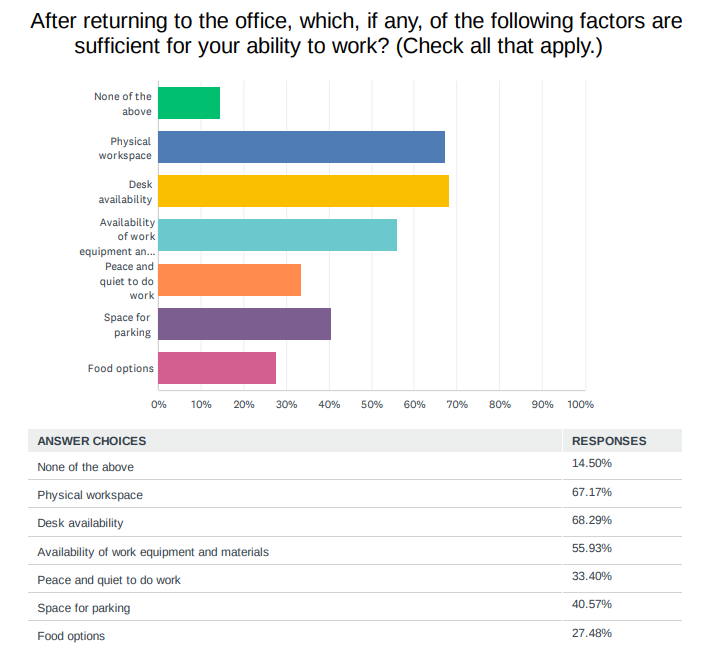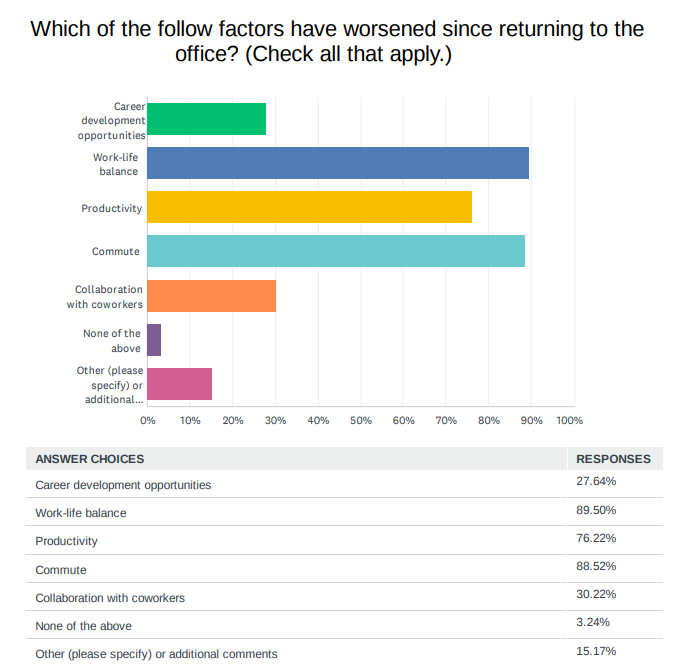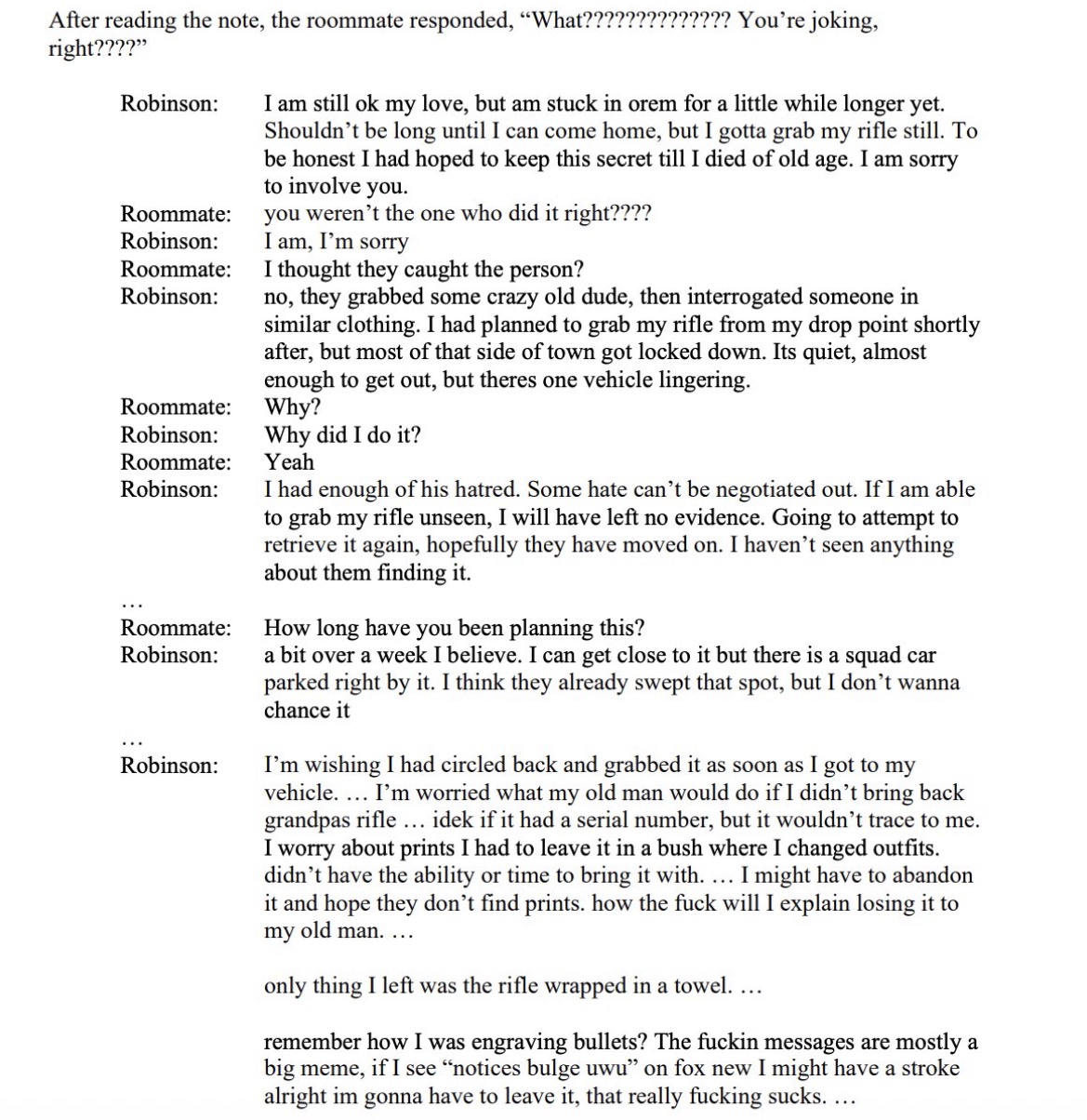Politics
Parking chaos and no toilet paper: An inside look at the federal return-to-office

Some federal employees anticipated President Donald Trump’s return-to-office order to be a mess — and for many, that’s now turned out to be the case.
A Federal News Network survey, conducted March 17-21, asked how federal employees have been faring since returning to the office full-time. The survey results showed that for the most part, feds’ experiences at work have plummeted.
Out of the more than 5,500 federal employees who took our survey, nearly 80% said “none of the above” when asked what has improved since heading to work on-site full-time. Instead, many said things have gotten much worse.
Source: Federal News Network March 2025 return-to-office survey of 5,500 federal employees. The survey is a non-scientific survey of respondents who were self-selected.
“I spend time and money commuting longer to do exactly what I do from home, with less productivity, more background noise, more interruptions, worse amenities, worse food and no one I actually work with,” one survey respondent said.
“Nothing has improved — actually, all areas are worse,” another employee said. “Limited bandwidth makes it harder to do my job. There are no IT peripherals and no money to purchase any. It’s loud in workspaces with virtual meetings. There are long lines to get onto the campus and in the building. There’s no parking, no cafeteria and low morale.”
‘Packed in like sardines’
Back in January — before agencies began requiring their employees to report to the office full-time — a previous Federal News Network survey found that two-thirds of respondents were either “very” or “extremely” concerned that their agency wouldn’t have enough space to accommodate the change.
For many federal employees, those predicted problems have become a reality. When asked what factors in the workplace are sufficient, the answers from survey respondents were largely mixed. About two-thirds said there was sufficient physical space and desk availability.
 Source: Federal News Network March 2025 return-to-office survey of 5,500 federal employees. The survey is a non-scientific survey of respondents who were self-selected.
Source: Federal News Network March 2025 return-to-office survey of 5,500 federal employees. The survey is a non-scientific survey of respondents who were self-selected.
Still, that leaves about one-third of federal employees who took the survey saying they don’t have enough space. At some buildings, there are shortages of anywhere from 80 to 100 desks, according to a few respondents.
Many federal employees are reporting that they’ve instead been posted up in conference rooms, training rooms, cafeterias and hallways. Some are even working out of storage closets.
“I still do not have an assigned desk and I’m in a conference room with 20 others,” one employee who took the survey said. “We are packed in like sardines.”
Those who do have their own desk consider themselves “lucky.”
“I am lucky to have been grandfathered into having a permanent desk because I have been coming a long time,” one employee said. “Other people are posted in conference rooms.”
“My desk is a card table,” another said.
Work-life balance, productivity declining
And even in offices where there are enough desks and space is relatively sufficient, many said they are still working in crowded and noisy rooms, as others take calls and meeting around them in the open spaces.
Just about one-third of survey respondents said they have enough peace and quiet to do their work. In contrast, many said they aren’t able to concentrate, leading to worsening productivity.
“We have plenty of desks, but constant noise and interruptions have plagued our ability to focus,” one survey respondent said.
“Some people will never wear headphones, no matter how many calls they take,” another employee said.
When asked what factors have gotten worse since the return-to-office push, work-life balance, the commute and productivity were the most common answers, according to the spread of survey respondents.
 Source: Federal News Network March 2025 return-to-office survey of 5,500 federal employees. The survey is a non-scientific survey of respondents who were self-selected.
Source: Federal News Network March 2025 return-to-office survey of 5,500 federal employees. The survey is a non-scientific survey of respondents who were self-selected.
Some employees also said they aren’t working in the same office as anyone on their actual work team. Instead, they are working around colleagues who are focused on completely different work, leading to more distractions.
“I have no privacy as I share a cubicle with another employee from a different agency,” one employee said. “It is hard to have meetings and we both are in functions that require meetings with outside stakeholders.”
And despite being in the office, some employees said they are still holding all their meetings virtually any way because there isn’t enough space to meet in person.
“It doesn’t make sense. I’m not with my team, and this does not promote cohesion,” an employee said. “It’s a silly check in the box to say that federal employees reported back to the office. It’s less efficient and does not have adequate IT facilities to carry out the required mission.”
Many see unstable internet connections
Many employees are also unable to access the basic office infrastructure they need to do their work. Internet connectivity and limited Wi-Fi are common problems, according to the survey results.
Some employees said the internet connection in their office building isn’t strong enough to support the massive influx of people trying to connect every day. Many who rely on an internet connection to do their work are stuck waiting for browsers to load, and not getting any work done in the meantime.
“Our internet crashes all day long,” one respondent said. “I literally sit there for hours without access.”
“The internet doesn’t work half the time, so we just sit there doing nothing,” another employee said.
In one anecdote, a federal employee said, “We lost power to our whole building and spent the afternoon on a generator.”
As a result, many employees have resorted to using hot spots on their phones to connect to the internet — but even then, some said that solution isn’t really working.
As one employee described, “The place they told me to report for work had broken internet. So, they told me to use my hot spot. When I informed them I do not have a work phone so I cannot use my hot spot, they told me to use a stranger’s hot spot. Then they ordered me a brand-new iPhone 15 so I can hot spot at the office with my colleagues in a different state.”
Parking is ‘a disaster’ after return-to-office
On top of now having to make the commute to the office — which on its own can take quite some time, depending on the location — some employees who took the survey also described the parking situation at federal office buildings as “a disaster.”
Just about 40% of survey respondents said there was sufficient space for parking at their building. Some employees said they head into the office much earlier than needed to try to get a parking spot for the day. And if they arrive on time rather than early, some will spend upward of 30 minutes circling a parking lot in search of a spot.
“Parking is a disaster if you don’t come in early,” one employee said.
“If you arrive late, good luck finding a parking space,” another said.
In response, some agencies appear to have instituted lottery systems for letting employees park in garages near the building. Others are asking for employees to pay for parking passes daily, but federal workers said the day passes often run out quickly. Those who don’t get a parking spot are resorting to street parking — or sometimes finding more creative options.
“People have been parking on the grass next to the parking lot because the lot fills up,” one survey respondent said. “Our director warned us that police will start ticketing.”
Office supplies regularly run low
Once inside the office buildings, federal employees are reporting shortages of IT equipment, computer monitors, desk chairs — and yes, even toilet paper.
Some buildings ran completely out of toilet paper within the first few days of the return-to-office mandate, according to some survey respondents. And even when they manage to restock, supplies still run short frequently.
The shortages come in large part from a freeze on government payment cards, which has barred agencies from purchasing standard office supplies. Instead, many employees said they’ve had to bring their own personal supplies to work.
“We do not know when we will have monitors, keyboards and other equipment for the office,” one survey respondent said. “Some people have desks, but no chairs.”
At the same time, some employees said they’ve also seen trash cans overflowing, bathrooms not getting cleaned — and even pests, like cockroaches or mice.
Some federal employees are also waiting in long lines to go through security or use their buildings’ elevators every day. In less common cases, elevators have malfunctioned or broken down.
“Every morning and every evening, people are queued outside elevators, or they must take stairs from the ground floor anywhere up to level 31,” one employee said.
“In the last week, four people have been stuck in the elevators,” another employee said.
Some view return-to-office push as a strategy to cut employees
The Trump administration’s approach to returning employees to the office is a sharp departure from how agencies were handling the post-pandemic work environment for the last few years.
Prior to the full-scale return-to-office push, more than half of the federal workforce was already working on-site full-time due to the in-person nature of their jobs. The 46% of federal employees who are able to telework in the first place were spending about 60% of their work hours on-site by the end of the Biden administration. Just 10% of the federal workforce was working entirely remotely.
Throughout the Biden administration, the Office of Personnel Management viewed hybrid work — or a combination of on-site work and telework — as largely beneficial to the federal workforce.
“Agencies report notable improvements in recruitment and retention, enhanced employee performance and organizational productivity and considerable cost savings when utilizing telework as an element of their hybrid work environments,” OPM said in its telework report to Congress last year. “Thoughtfully implemented alongside meaningful in-person work, telework has the potential to significantly enhance the agility, productivity and engagement of our workforce. It has enabled the government to attract and retain diverse, top-quality talent from across the nation.”
But in Federal News Network’s latest survey, some respondents speculated that Trump’s return-to-office mandate is a veiled attempt to get more federal employees to leave their jobs.
“The return-to-office mandate is contrived and rhetorical,” one employee said. “It is being used to make life more difficult for employees in the hopes we quit.”
In a Wall Street Journal op-ed last fall, billionaire Elon Musk indicated as much.
“Requiring federal employees to come to the office five days a week would result in a wave of voluntary terminations that we welcome,” the op-ed reads. “If federal employees don’t want to show up, American taxpayers shouldn’t pay them for the Covid-era privilege of staying home.”
A number of federal employees have voluntarily left their jobs in the last few months, but it’s unclear how often the return-to-office push was the main driving force behind that attrition. The Trump administration has at the same time been pushing forward with many other attempts to significantly cut the federal workforce, both voluntarily and by mandate.
Still, many federal employees have said they plan to stay in their jobs despite the strict return-to-office requirements.
“It’s completely unnecessary and we recognize the reason for it: To make us so miserable that we quit,” one employee said. “But most of us won’t out of sheer spite.”
The post Parking chaos and no toilet paper: An inside look at the federal return-to-office first appeared on Federal News Network.
Politics
Black Lives Matter Activist in Boston Pleads Guilty to Federal Fraud Charges – Scammed Donors to Fund Her Lifestyle

Screencap of YouTube video.
A Black Lives Matter activist in Boston named Monica Cannon-Grant pleaded guilty to federal charges this week, admitting that she scammed donors and used their money to fund her own lavish lifestyle.
Cannon-Grant was previously held up as an admired figure. The city of Boston named her the Bostonian of the year at one point for her ‘social justice activism’ and she was even recognized by the Boston Celtics basketball team for her efforts.
She is now facing a minimum of two years in prison.
The New York Post reports:
BLM-linked activist admits conning donors to fund her lavish lifestyle
A once-celebrated Boston social activist has pleaded guilty to defrauding donors — including Black Lives Matter — out of thousands of dollars that she used as a personal piggy bank.
Monica Cannon-Grant, 44, pleaded guilty Monday to 18 counts of fraud-related crimes that she committed with her late husband while operating their Violence in Boston (VIB) activists group, according to the US Attorney’s Office in Massachusetts.
The activist scammed money — including $3,000 from a BLM group — while claiming it was to help feed children and run protests like one in 2020 over the murder of George Floyd and police violence.
Cannon-Grant also conned her way into getting $100,000 in federal pandemic-related unemployment benefits — which she used to pay off her personal auto loan and car insurance policy.
But she has now confessed to transferring funds to personal bank accounts to pay for rent, shopping sprees, delivery meals, visits to a nail salon — and even a summer vacation to Maryland.
Just amazing.
Monica Cannon-Grant stole from donors, scammed the government, and lived it up while preaching about oppression. BLM grift is the only nonprofit where fraud is part of the mission statement. https://t.co/ir3q9lqYrh
— Matthew Newgarden (@a_newgarden) September 23, 2025
BREAKING: BLM activist Monica Cannon-Grant pleads guilty to 27 fraud charges, misusing over $1M from Violence in Boston for personal gain. Echoes Sir Maejor Page’s $450K scam conviction. A wake-up call for nonprofit accountability. pic.twitter.com/N9vvD369gB
— (@pr0ud_americans) September 14, 2025
Here’s a local video report:
She should pay back every penny.
The post Black Lives Matter Activist in Boston Pleads Guilty to Federal Fraud Charges – Scammed Donors to Fund Her Lifestyle appeared first on The Gateway Pundit.
Politics
Keith Olbermann Backpedals Furiously With Apology for Threatening CNN’s Scott Jennings – Jennings Responds (VIDEO)

As the Gateway Pundit reported yesterday, former MSNBC host and generally unhinged leftist Keith Olbermann, appeared to threaten CNN’s conservative pundit Scott Jennings on Twitter saying, ‘You’re next motherf**ker.’
Well, Olbermann may have gotten a phone call or a visit from the FBI because today he walked back those comments with a full-throated apology.
RedState has an update:
To quickly recap, Scott Jennings, a Salem Media Network radio host and conservative CNN political commentator, reacted to breaking news on Monday that Kimmel had been reinstated by tweeting, “So basically his employer suspended him for being an insensitive pr**k, and we don’t live in an authoritarian regime? Got it.”
This enraged Olbermann, who proceeded to tweet what many, including Jennings, perceived to be a threat. “You’re next, motherf**ker. But keep mugging to the camera.” Jennings tagged Patel and included a screengrab of the tweets in response.
Though the FBI hasn’t commented as to whether an investigation was launched, Olbermann ostensibly appears to have thought twice about what he tweeted and deleted, apologizing profusely in tweets posted on Tuesday and claiming what he wrote was “misinterpreted”:
See Olbermann’s tweet below:
I apologize without reservation to @ScottJenningsKY
Yesterday I wrote and immediately deleted 2 responses to him about Kimmel because they could be misinterpreted as a threat to anything besides his career. I immediately replaced them with ones specifying what I actually meant. pic.twitter.com/SPWLb73nEk
— Keith Olbermann (@KeithOlbermann) September 23, 2025
I oppose and condemn political violence, and the threat of it. All times are the wrong time to leave even an inadvertent impression of it – but this time is especially wrong
I should've acknowledged the deletion and apologized yesterday. I'm sorry I delayed.
— Keith Olbermann (@KeithOlbermann) September 23, 2025
Scott Jennings, always a class act, offered this hilarious response:
SCOTT JENNINGS: “Marking myself SAFE from that NUT, Keith Olbermann!” pic.twitter.com/EYZX6vm5Oh
— Dustin Grage (@GrageDustin) September 23, 2025
Keith Olbermann really needs help. The guy is just so out of control.
The post Keith Olbermann Backpedals Furiously With Apology for Threatening CNN’s Scott Jennings – Jennings Responds (VIDEO) appeared first on The Gateway Pundit.
Politics
Where is Lance Twiggs? Kirk Assassin’s Transgender Lover Has Vanished

 Charlie Kirk assassin Tyler Robinson and roommate Lance Twiggs
Charlie Kirk assassin Tyler Robinson and roommate Lance Twiggs
Charlie Kirk assassin Tyler Robinson lived with his transgender partner – a male-to-female trans named Lance “Luna” Twiggs.
The FBI used Robinson’s texts with his transgender partner to solidify that Robinson was the assassin. Lance Twiggs has not been charged with any crime; however, federal authorities are still investigating.
Last week, Utah authorities released the text exchange between Tyler Robinson and his transgender lover, Lance Twiggs, sent shortly after Kirk’s assassination.
Utah County District Attorney Jeff Gray announced seven charges against Charlie Kirk assassin Tyler Robinson. They will also be seeking the death penalty.
Robinson was charged with:
– Count 1: Aggravated murder (capital offense)
– Count 2: Felony reckless discharge of a firearm causing bodily injury
– Count 3: Felony obstruction of justice for hiding the firearm
– Count 4: Felony obstruction of justice for discarding the clothing he wore during the shooting
– Count 5: Witness tampering for asking roommate to delete incriminating messages
– Count 6: Witness temperating for demanding trans roommate stay silent, and not speak to police
– Count 7: Commission of a violent offense in the presence of a child
Jeff Gray released the chilling texts between Tyler Robinson and his “love” Lance Twiggs.
Read the text exchange here:
 Tyler Robinson texts with transgender lover Lance Twiggs / 1
Tyler Robinson texts with transgender lover Lance Twiggs / 1
 Kirk assassin Tyler Robinson texts with transgender lover Lance Twiggs / 2
Kirk assassin Tyler Robinson texts with transgender lover Lance Twiggs / 2
Lance Twiggs was reportedly cooperating with the FBI, however, according to the Daily Mail he has seemingly vanished.
“If [Lance Twiggs] ever comes back, it will be in a body bag,” a neighbor said to the Daily Mail. “That’s not a threat – I’m just saying that there are so many people who want a piece of him he’d be mad to show his face in public again. This was a generational event.”
The Daily Mail reported:
The Trans boyfriend of Charlie Kirk’s alleged assassin has fled their former lovenest – and locals tell the Daily Mail they never want to see him again.
Lance Twiggs, 22, was led away for questioning when police swooped on the smart three-bed condo he shared with accused gunman Tyler Robinson, 22.
Shaken neighbors say the part time plumber has not been back to the $320,000 property in St. George, Utah – one declaring: ‘Good riddance. I never want to see either of them again.’
His beaten-up Infinity compact is still parked in his space with his work gear tossed across the back seat and a sandwich wrapper and a drink on the front passenger seat.
Upstairs lights have been left on for more than a week and notes and Amazon packages are piling up outside the home owned by Twiggs’s devout Mormon family.
The post Where is Lance Twiggs? Kirk Assassin’s Transgender Lover Has Vanished appeared first on The Gateway Pundit.
-

 Entertainment6 months ago
Entertainment6 months agoNew Kid and Family Movies in 2025: Calendar of Release Dates (Updating)
-

 Entertainment3 months ago
Entertainment3 months agoBrooklyn Mirage Has Been Quietly Co-Managed by Hedge Fund Manager Axar Capital Amid Reopening Drama
-
Tech6 months ago
The best sexting apps in 2025
-

 Entertainment5 months ago
Entertainment5 months agoKid and Family TV Shows in 2025: New Series & Season Premiere Dates (Updating)
-

 Tech7 months ago
Tech7 months agoEvery potential TikTok buyer we know about
-
Tech7 months ago
iOS 18.4 developer beta released — heres what you can expect
-

 Tech7 months ago
Tech7 months agoAre You an RSSMasher?
-

 Politics7 months ago
Politics7 months agoDOGE-ing toward the best Department of Defense ever



